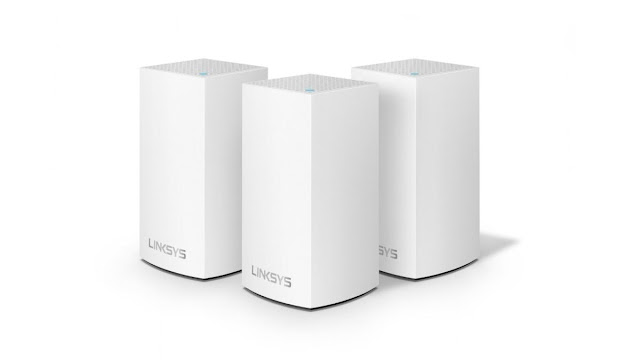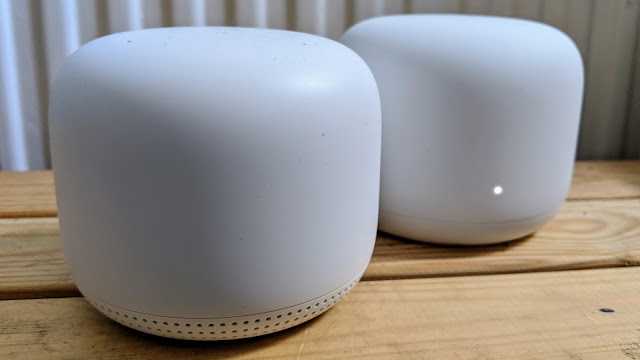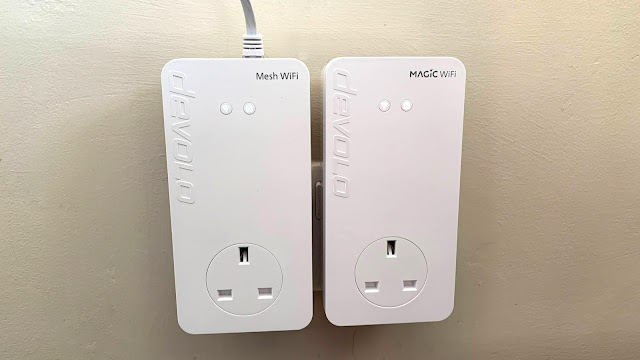Mesh Wi-Fi systems connect to your existing router and provide a strong Wi-Fi signal all around your home. These are the best kits to buy.
If you live in a relatively large home, you’re probably unhappy that your existing Wi-Fi router – which was probably free from your broadband provider – can’t give you a good internet connection in every room.
Maybe it does reach every room, but the speeds are probably quite slow in those farthest from the router, and the signal almost certainly doesn’t cover any outdoor areas, such as a garden, or outbuildings such as a garage or shed. And as good as Wi-Fi is, it’s easily thwarted by walls, ceilings and other obstacles.
Upgrading to a newer, better router is one option, but there’s now an alternative: mesh Wi-Fi routers.
They don’t replace your old router entirely: just the Wi-Fi part. You simply connect one of your new mesh Wi-Fi devices (variously called nodes, satellites, hubs and other things by different manufacturers) to your router and it works with the other units that came in the kit to cover your whole home with a fast, strong signal.
In smaller homes, including apartments, mesh Wi-Fi might not be required. You could save money by upgrading your old router, but if you want excellent Wi-Fi across your home and garden, then a mesh system is the answer.
So if you’re still struggling along with the Wi-Fi router you got years ago, a mesh Wi-Fi system will be a revelation. No more stuttering Zoom calls, no web pages loading really slowly and no buffering when streaming Netflix or YouTube videos.
If a mesh Wi-Fi systems sounds complicated, don’t worry. They’re really easy to install. You don’t have to change your internet provider, and you keep your old router. Ideally you should disable its Wi-Fi so it doesn’t interfere with the new network, but quite a few manufacturers now say you can simply leave it on if you want to.
The best news is that mesh Wi-Fi systems don’t have to cost a lot. Prices start from as little as $80/£70, but if you want the latest, fastest models, you’ll pay a lot more. What’s important is to match the speed of a mesh Wi-Fi system to your broadband speed. There’s no point in paying over the odds for one that delivers gigabit speeds if your broadband runs at only 70Mbps.
It’s also useful to know that Wi-Fi 5 systems aren’t necessarily slower than Wi-Fi 6 kits, even though many people assume they will be. Prices usually reflect the speeds you can expect.
Coverage isn’t always dependent on price. Mesh kits usually include two or three devices – called nodes – which communicate with each other wirelessly and provide a single Wi-Fi network over a much larger area than a single router can. Your devices will disconnect from one node and connect to a closer one as you move around your home.
So no matter whether you have a large single-storey home, such as a bungalow, or a town house with several floors, a mesh system will be a huge upgrade. And if you discover you need more mesh routers, you can usually buy them individually and add them to the system using the companion app on your phone.
Some mesh systems – such as the TP-Link Deco P9 – can even use your home’s mains wiring to talk to each other using powerline networking instead of Wi-Fi. This is useful if your home has very thick walls, or is constructed from materials which block Wi-Fi (such as metal). Or, if your home is wired for Ethernet, a lot of mesh systems let you connect nodes together using network cables. This is called Ethernet backhaul, and it allows you to place them further apart, even in an outbuilding such as a garage or shed.
Here we’ve reviewed and ranked the best mesh Wi-Fi 5 and 6 systems for all budgets.
1. TP-Link Deco P9
Cons
- Not the fastest speeds
It’s easy to set up, has a well-designed and feature-packed app and can offer fantastic coverage. That’s because, unlike most other mesh systems, the Deco P9 uses a combination of mesh Wi-Fi and Powerline networking which uses your home’s mains wiring to provide a reliable connection even through thick walls, which is something other systems can’t do much about.
It’s a dual-band Wi-Fi 5 system, but technically it’s tri-band because it can use Powerline for ‘backhaul’, which means the mesh units can talk to each other even if they’re further apart than Wi-Fi allows.
While it was originally available only in a set of three offering up to 6000 square feet of coverage, TP-Link has since launched a two-unit set ideal for smaller homes.
If you want a mesh Wi-Fi system that doesn’t depend on Wi-Fi for the units to communicate with each other, the Deco P9 is ideal.
Read our full TP-Link Deco P9 review
2. Amazon Eero 6
- Great speeds
- User-friendly app
Cons
- No Ethernet ports on satellites
- Security features require subscription
We were impressed with the original Eero system, but this is Amazon’s Wi-Fi 6 version – hence the 6 in the name. It’s a dual-band kit, and if you want better performance there’s the Eero 6 Pro which is a tri-band system.
The Eero 6 has a Zigbee hub built in, which could be handy if you have Philips Hue or other Zigbee-based smart home devices.
Note that the satellites in the kit aren’t identical to the main router: they don’t have any Ethernet ports (unlike the original Eero) which could be a deal-breaker if you need to connect a PC or any other device that doesn’t have Wi-Fi.
Assuming that’s not a problem, the Eero 6 is just as impressive as the original, with a great app and easy setup. Of course, performance is also excellent, though you’ll need devices with Wi-Fi 6 to get the best speeds from the system.
The original Wi-Fi 5-based Eero system is still on sale and is cheaper, and a good alternative if you don’t need Wi-Fi 6 yet – or Zigbee.
If there’s one drawback, it’s the fact some features are locked away behind a subscription. We hope other mesh systems don’t adopt this strategy.
Read our full Amazon Eero 6 review
3. Linksys Velop Dual Band
- Two Gigabit Ethernet ports per node
- Affordable
Cons
- Basic parental controls
Although the app could be a bit slicker, we really have no complaints about the Linksys Velop dual-band. Especially now that you can buy it for significantly less than what it cost when it originally launched, and it was already a lot cheaper than the expensive Velop tri-band.
Via the app you can manage the network, enable guest Wi-Fi and create basic access rules to limit internet time for specific devices.
It provides a reliable wireless network with decent speeds that should satisfy most families. And each of the units has two Gigabit Ethernet ports for connecting devices that don’t have Wi-Fi.
It doesn’t have any built in ‘smart hub’ like some mesh kits, meaning you can’t use it to connect Philips Hue bulbs or other Zigbee or Z-Wave devices.
Read our full Linksys Velop Dual Band review
4. Netgear Nighthawk Mesh WiFi 6 System
- Affordable
- Good performance
Cons
- Netgear Armor requires subscription
- Single Ethernet port on satellites
Another entry-level Wi-Fi 6 mesh system, Netgear’s Nighthawk is simple to set up and use, and its reach can be expanded by adding more satellites.
Also like the Eero 6, this is a dual-band system that lacks an additional 5GHz third band for communication, so isn’t as fast as Netgear’s tri-band Orbi system (which is also a lot more expensive). Some users will find the lack of Ethernet ports limiting, but at least there is one on each satellite, unlike the Eero 6.
Like the Eero 6, security software runs on the routers themselves, protecting all your devices – even those that can’t have software installed, such as smart speakers or security cameras. Unfortunately, when the initial period expires you have to subscribe to keep the protection.
Overall, the Nighthawk Mesh WiFi 6 System is an effective way to pipe Wi-Fi 6 around your home.
Read our full Netgear Nighthawk Mesh WiFi 6 System review
5. Tenda Nova MW3
- Costs less than many single routers
Cons
- Basic app
- Not the fastest speeds
The MW3 is the cheapest mesh networking system we’ve reviewed. It has dropped in price since it was launched, making it a very tempting option for those on a tight budget.
As you’d expect, it can’t match the performance of more expensive rivals, but it still does a great job of delivering a strong Wi-Fi connection and eliminating dead zones around your home. Obviously, it doesn’t support Wi-Fi 6, but instead Wi-Fi 5, which is still perfectly good for streaming video, playing games and other internet activities.
That makes it a terrific bargain if you just need to provide a good internet connection around an average-size home, rather than have the ultimate Wi-Fi speeds.
Read our full Tenda Nova MW3 review
6. Google Nest WiFi
- Slick hardware and app
- Google Assistant built in
Cons
- Expensive
- Not Wi-Fi 6
The current version of Google’s mesh Wi-Fi system has evolved quite considerably. The main unit (and additional ‘points’) are also smart speakers with the Google Assistant, so this mesh system will save you if you were planning to buy one or more Google Nest speakers, along with using fewer mains outlets and you have fewer devices littered around your home.
If there’s a disappointment it’s that the kit doesn’t support the latest Wi-Fi 6 standard, but Nest WiFi is plenty fast enough for the average home and will improve signal around even smaller house vs a regular router.
Of course, you also get great Google software which makes the whole process simple and easy to use. Not only it is a breeze to get set up, but the features are accessible and helpful including a guest network, priority devices and parental controls. You can even pause the network with your voice via the Google Assistant.
Read our full Google Nest Wifi review
7. Amazon Eero
- Compact units
- 2 Ethernet ports per router
Cons
- Slower than Eero 6
The original Eero system is simple, elegant and works well. It’s also easy to set up and monitor using the companion app.
Wireless speeds are respectable, though if you want something a little faster, then a tri-band Eero Pro system might be just the ticket.
Gamers, home office workers or anyone with a lot of devices that work better with a wired connection will find the two Ethernet ports per Eero very useful (and you can add more with an inexpensive Ethernet hub). Plus, most people will be happy with the wide-ranging wireless coverage the system delivers.
Read our full Amazon Eero Mesh Wi-Fi review
8. Devolo Mesh WiFi 2 review
- Powerline & Wi-Fi
- Easy to expand
Cons
- Expensive
- App could be better
The Devolo Mesh Wi-Fi 2 kit offers the best of both worlds in terms of home networking. Devolo calls it a ‘tri-band’ system because it uses Powerline – the latest G.hn standard – to communicate between adapters. That means you can plug in adapters much further apart than Wi-Fi would allow, so it’s ideal for larger homes or those with particularly thick walls or constructions that block Wi-Fi signals.
Unlike the previous Magic 2 kit, each adapter in the Mesh Wi-Fi 2 kit is identical, and all have Wi-Fi.
But they are essentially the same as the Magic 2 units, and you can use individual Magic 2 adapters to expand the system if you need more than three Wi-Fi hotspots.
You don’t even lose a mains socket as each device has a pass-through socket as well as two Ethernet ports for connecting PCs or other devices without Wi-Fi.
Despite not offering Wi-Fi 6, this kit will cost a similar amount to those that do. We’re not the biggest fans of the app, either, as it isn’t particularly nice to use and doesn’t offer all that many features. However, if you’re after a mesh system for a larger home, this one really delivers.
Read our full Devolo Mesh WiFi 2 review
9. Amazon Eero Pro 6
- Good coverage
- Slick app
- Subscription required for some key features
- Expensive
The Eero Pro 6 is easy to set up and reliable in use. Performance is very good, but not amazing considering how expensive it is. If you have Gigabit broadband, you’ll want to look elsewhere to get that speed over Wi-Fi.
The app is great, but Eero puts too many features behind a paywall and doesn’t include enough ‘pro’ features.
If you don’t mind the cost, have lots of Wi-Fi 6 devices already and don’t need the full Gigabit speeds, the Eero Pro 6 is a great mesh system. But for most people right now, the extra cost isn’t worth it.
Read our full Eero Pro 6 review












0 comments:
Post a Comment